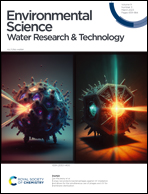The diversity of aluminum-based drinking water treatment residuals for use in environmental remediation†
Abstract
Drinking water treatment residuals (DWTRs) are complex mixtures of organic and inorganic phases generally disposed of as waste materials. However, their strong sorptive properties could be further exploited to immobilize contaminants. To characterize these materials, we applied a range of analytical techniques to a set of aluminum-based DWTRs. We determined surface areas, elemental compositions using CHNS analysis and X-ray fluorescence (XRF), performed thermogravimetric analyses paired with mass spectrometry (TGA-MS), and used synchrotron-based methods: X-ray diffraction (XRD) and X-ray absorption spectroscopy (XAS). Elemental analyses and specific surface area measurements – that vary between 7.23 ± 0.03 and 197.6 ± 0.9 m2 g−1 – indicate that non-coagulant additives must play an important role in controlling sorption. High resolution powder XRD reveals the presence of only a few crystalline minerals mostly derived from source waters or additives. Fe was detected by XRF in all samples, whereas Mn was present in significant levels in samples with potassium permanganate as additive. The chemical speciation of these elements was characterized by performing spectral decompositions of XAS spectra. The spectral features of Fe are consistent with iron(III) oxides/hydroxides and structural iron in clays. On the other hand, Mn is predominantly present under its reduced form, Mn(II).



 Please wait while we load your content...
Please wait while we load your content...